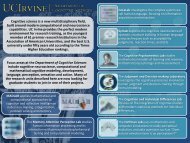Conscious Realism and the Mind-Body Problem - UCI Cognitive ...
Conscious Realism and the Mind-Body Problem - UCI Cognitive ...
Conscious Realism and the Mind-Body Problem - UCI Cognitive ...
You also want an ePaper? Increase the reach of your titles
YUMPU automatically turns print PDFs into web optimized ePapers that Google loves.
<strong>Conscious</strong> <strong>Realism</strong> <strong>and</strong> <strong>the</strong> <strong>Mind</strong>-<strong>Body</strong> <strong>Problem</strong> 97hypo<strong>the</strong>sis than HFD: Both say perception represents an objective world;but HFD claims, in addition, that perception resembles that objectiveworld. MUI <strong>the</strong>ory makes no such claim.For instance, if you experience a rock or tree, HFD claims that, barringillusion, <strong>the</strong>re must be a rock or tree in <strong>the</strong> objective world whoseproperties approximate those of your experience. MUI <strong>the</strong>ory is not committedto this claim. It allows countless possibilities for what in <strong>the</strong>objective world triggered your experience. Chances are <strong>the</strong>re is no matchbetween properties of experience <strong>and</strong> <strong>the</strong> objective world. Instead perceptualexperiences are, in <strong>the</strong> typical case, much less complex <strong>and</strong> differentlyformatted than <strong>the</strong> objective properties that trigger <strong>the</strong>m. This failureto match, due to adaptive simplification <strong>and</strong> reformatting, is key to <strong>the</strong>usefulness of perceptual experiences. Concern about veridicality of perceptionis a category error. The proper concern is whe<strong>the</strong>r perceptionusefully informs action.According to MUI <strong>the</strong>ory, <strong>the</strong> objects of everyday experience – tables,chairs, mountains, moon – are not public. If, for instance, I h<strong>and</strong> you aglass of water, it is natural, but false, to assume that <strong>the</strong> glass I once heldis <strong>the</strong> same glass you now hold. Instead, according to MUI <strong>the</strong>ory, <strong>the</strong>glass I held was, when I observed it, an icon of my MUI, <strong>and</strong> <strong>the</strong> glassyou now hold is, when you observe it, an icon of your MUI, <strong>and</strong> <strong>the</strong>y arenumerically distinct. There are two glasses of water, not one. And if athird person watches <strong>the</strong> transaction, <strong>the</strong>re are three glasses.This claim seems, to most, absurd, <strong>and</strong> straightforwardly refuted.Searle (2004, pp. 275ff), for instance, argues against <strong>the</strong> denial of publicphysical objects as follows: First, we all assume, quite naturally, that wesometimes communicate successfully. This requires that we have publicmeanings in a public language, so that we can both mean, or intend, <strong>the</strong>same thing by utterances such as “this glass of water”. But this requiresthat we have publicly available objects of reference, e.g., a publicly availableglass of water, so that when I say “this glass of water” I am referringto <strong>the</strong> same object as you do when you say “this glass of water”. Thisimplies that we share perceptual access to <strong>the</strong> same object, which makes ita public object. Thus, concludes Searle, <strong>the</strong>re are public physical objects<strong>and</strong> <strong>the</strong> correct philosophy of perception is direct realism.This argument is seen false by counterexample. Bob <strong>and</strong> Tom, playingvirtual tennis, can talk meaningfully about “<strong>the</strong> tennis ball” <strong>the</strong>y hit; <strong>the</strong>ycan agree that Tom hit “<strong>the</strong> tennis ball” out of court, thus losing a point.There is, patently, no public tennis ball. Instead, a supercomputer in<strong>the</strong> back room feeds signals to <strong>the</strong> helmet displays of Bob <strong>and</strong> Tom <strong>and</strong>each, in consequence, constructs his own tennis-ball experience. But Bob’stennis-ball experience is numerically distinct from Tom’s. And <strong>the</strong>re isno o<strong>the</strong>r tennis ball around to serve <strong>the</strong> role of public tennis ball. Thuspublic physical objects are not required for meaningful communication.







